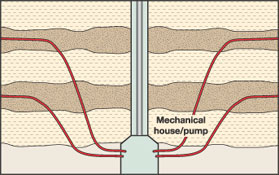What's happening in production
A new strategy for mining oilAlso called Mining Assisted Petroleum Development, the idea of mining oil is not new. World Oil ran a story on the idea in its November 1996 issue. At that time, PetroTech was the company that was planning to apply the method to Corsicana field in Texas. It never happened. The idea resurfaced on the cover of the RMOTC newsletter. Omega Oil Co., Inc., recently completed a feasibility / economic study for constructing a below-the-reservoir production facility at RMOTC in the Shannon formation, Teapot Dome. The results took Omega to the next step: a comprehensive engineering study that will include civil, electrical, mechanical mining, drilling and specialized safety design, together with a detailed cost estimate based on the design criteria. Shannon reservoir is characterized by low pressure, shallow, tight sandstone with a high degree of compartmentalization. Production data indicates that the Shannon will produce economically when oil is found in one of these compartments where sufficient energy is available to induce oil migration. Closely spaced horizontal wells should provide superior access to individual compartments.
The project calls for the drilling of about 40, 4-3/4-in.-ID horizontal wellbores (about 100,000 total lineal ft) within the production zone(s). The wells produce to a wellhead located in a concrete drill room that is 1,000 ft subsurface. The drill room is served by a 10-ft-dia. shaft that is divided into a large and a small compartment: one for primary hoisting and the other for utility conduits. The company believes that, if successful, this proprietary technology should cut operating and development costs, increase recovery rates and reduce the environmental impact of producing shallow crude and gas. Operating and development costs would be lower due to fewer pumps, wellsites and a single, centralized wellhead. Higher recovery rates result from the high density of horizontal wellbores – up to 200 radially; reduction of wellbore back-pressure (from gravity drainage); and maximizing differential pressure. Environmental benefits result from having only one wellsite rather than 40-acre-spaced surface wells. For example, production of hydrocarbons from an 8,500-acre area would create surface disturbance of only about 7 acres – including well site, pipelines, power lines and access roads. The technology could also be applied to the recent boom in coalbed methane, since the radial-gravity drainage idea would speed de-watering and subsequent gas collection with CBM wells. There are several differences between this idea and earlier "oil mining" methods. The most significant is due to advances in remote steering and control that allow all operations to be surface controlled, including coiled-tubing drilling of the radial laterals. But don’t drink the water. Netherlands-based Triqua B.V. will deliver a wastewater treatment system on an artificial drilling island in the Caspian Sea. The artificial island will lie in shallow water, about 45 mi offshore Kazakhstan. The company will design, manufacture, test and deliver a wastewater-treatment system to a man-made island in the Caspian sea. The system is based on a membrane-bioreactor principle. The island comprises a land drilling rig and a self-contained accommodation module, together with all support services for up to 120 people. Waste streams include domestic sewage, kitchen and laundry waste, and gray water from washing and showering. A membrane bioreactor combines biological treatment with membrane filtration. This combination results in a compact system with good effluent quality, including possible water reuse. Pre-treatment comprises grease traps, a tilted-plate separator and a drum sieve. Post-treatment comprises activated-carbon filters, UV disinfecting and bactericide dosing, while the sludge treatment comprises sludge pre-conditioning and a filter press. Agip is now operator for field development on behalf of the OKIOC consortium. Oilfield bots. At OTC, Halliburton and Intelligent Inspection Corp. introduced two new robots – still under development – that they say will significantly reduce oil and gas operating costs, especially in deep water. An intelligent robot named MicroRig, which operates autonomously in a producing oil or gas well, is a wireless downhole-tractor tool. It incorporates advanced logic-control software that enables it to perform smart interventions in existing wells – as well as diagnostic measurements and routine maintenance – and then return to surface. It will initially be used within horizontal and highly deviated wells and will be more cost-effective than current tubing-conveyed methods associated with well logging and intervention. Another robot, called irobot Pro, allows the operator
to explore places by driving the robot from any web-browser in the world. The operator sees and hears what the
robot sees and hears, and can interact with equipment and colleagues by speaking through the robot, asking
questions and sharing ideas as if actually there. A tractor-driven device that can negotiate uneven terrain
and climb stairs, it incorporates a personal computer with sonar, infrared sensors and a video camera to allow
semi-autonomous operation.
|




